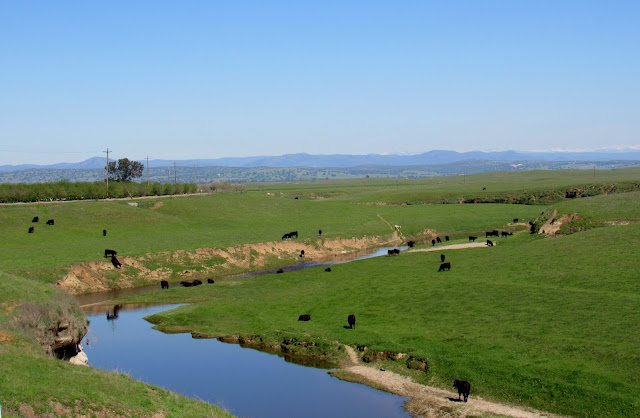Audubon's Important Bird Areas: La Grange/Waterford and Merced Grasslands
In my last post, I wrote about the importance of protecting California's remaining grasslands. Today, I would like to introduce you to two very special, very important grasslands that are both near and dear to my heart - as well as my hometown. Designated as Important Bird Areas by the National Audubon Society, the La Grange/Waterford Grasslands and Merced Grasslands collectively cover nearly 400,000 acres along the eastern edge of the San Joaquin Valley and the western extent of the Sierra foothills.
 |
| Merced Grasslands on a foggy winter morning |
Important Bird Areas are regions that the National Audubon Society, the United States' partner with BirdLife International, has determined encompass the most critical and important habitats for birds in the US. In California, a few of these areas include famed birding hotspots such as the Mono Lake Basin, Point Reyes and Tomales Bay, Humboldt Bay, Carrizo Plain, the Salton Sea and Imperial Valley, and the Lower Colorado River Valley. Across the United States, the habitat represented by Important Bird Areas is varied, as are the many threats they face.
 |
| Loggerhead Shrike, one of California's grassland Species of Special Concern |
 |
| State Threatened Tricolored Blackbirds |
One of two Important Bird Areas on the eastern edge of the Great Central Valley, the La Grange/Waterford Grasslands cover 189,945 acres in Calaveras, San Joaquin, Stanislaus and Tuolumne Counties between the Stanislaus and Tuolumne Rivers (see map below). This area is comprised of extensive grassland habitat and a few vernal pools, transitioning from grassland to blue oak savannah along the edge of the Sierra Nevada foothills. This land is privately owned, and more acres fall to agricultural expansion every year. Virtually no protected habitat occurs in this area, and there is essentially nothing stopping landowners from ripping up the grassland and converting it to orchards. A high diversity of wintering raptors occurs on this grassland, including Ferruginous and Rough-legged Hawks, as well as both Golden and Bald Eagles, and Burrowing and Short-eared Owls.
 | |
|
 |
| A spring day on the La Grange/Waterford Grasslands. Note the encroachment of almond orchards into unirrigated rangeland on the left side of the photo. |
The La Grange/Waterford and Merced Grasslands are almost entirely unprotected, their fate left to decisions made by landowners. While using our grasslands as rangeland for sustainably grazing livestock is about the best arrangement we can have, more and more landowners are choosing to plow up the grasslands and plant valuable nut crops instead. Drip irrigation allows growers to provide water to trees even on rolling hills, so the orchards continue to spread farther and farther into the grasslands every year.
Check out the satellite image below to see what I mean.
The image below is a closer look at the grasslands - and former grasslands - around Warnerville, right in the heart of the La Grange/Waterford Grasslands.
Winter is perhaps the most painful time for a naturalist to drive through these grasslands, since this is the time landowners plant new orchards of bareroot trees. It seems like every time I drive out across the grasslands I find that more and more acres of old-growth grassland have been stripped of their vegetation, the red earth laid bare. Acre after acre of former grassland is now planted in neat rows of little sticks, future orchards, sterile monocrops of almond trees which require supplemental water and heavy uses of chemical pesticides and fertilizers, to say nothing of rodent control measures.
 |
| A Golden Eagle soars over the La Grange/Waterford Grasslands |
Most, if not all, of the birds mentioned above cannot survive the unrelenting march of orchards. Their lifestyles are not suited to orchards and agricultural areas; once the grassland habitat becomes too highly fragmented, or lost entirely, the birds that depend on it must leave to seek their living elsewhere.
Ferruginous Hawks and Golden Eagles require vast expanses of open habitat to hunt rodents and small mammals; orchards with highly controlled squirrel populations offer nothing to these large raptors of wild western grasslands. Long-billed Curlew, a species of prairie-nesting shorebird, rely on open grassland, not orchards, for winter habitat. Meadowlarks, Horned Larks and several species of native sparrows nest on the ground in grasslands, concealed in clumps of vegetation; there is no place for these birds in an orchard.
Quite simply, when we lose the grasslands, we lose their birds.









My husband and I just saw a pair of bald eagles while driving. We were just outside of La Grange heading toward Waterford. No mistaking them. One flew across the road heading east, right in-front of us. The second was flying the same direction but we were up the road just getting to the intersection of La Grange.
ReplyDeleteThat's wonderful! I saw three Bald Eagles a few days ago close to that same general area at Modesto Reservoir. Always good to see. Thanks for reading and commenting!
Delete